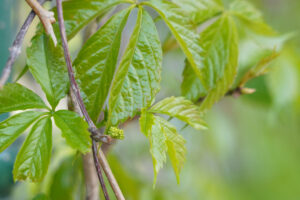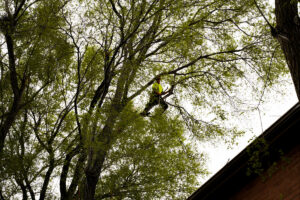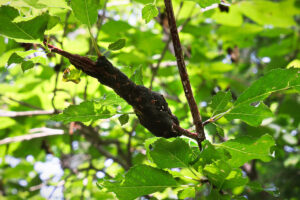Looking to intrigue friends or family this holiday season? Maybe you’re preparing for that inevitable game of holiday trivia? As you might expect, our team of ISA certified arborists are particularly keen on tree trivia, especially in the holiday season. We have some fun and interesting festive tree trivia for you which will surely capture some interest at the next Christmas party.
Where Did the Christmas Tree Come From?
Trees, both evergreens and deciduous trees like oaks, have a long history as symbols of life in various cultures, including Egyptians, Hebrews, Chinese, Romans, Saxons, Vikings, and many others throughout the rest of Europe. However, because of such diverse tree traditions, especially during the winter season, the origin of the current Christmas tree tradition is not clear. The origin is often said to be connected to an older tradition of the Yule tree. While Yule was a winter holiday which included the ceremonial cutting of a tree for the burning of a Yule log, there was no tradition of the Yule tree. Instead, there are numerous other possible influences. These include Pagan traditions of hanging and decorating individual fir tree branches and regional Christian practices of decorating a Paradise Tree for the name day of Adam and Eve on December 24th.
Likely, these traditions and practices combined over time. The first known Christmas trees were put up in German and Livonian guild halls in the 1400s. The ornaments were sweets and treats that the guilds’ apprentices and children would enjoy. The guilds would also sometimes move them to the town square for the whole community. The practice of decorating festive trees remained largely public, just as we still light up large trees together at Toronto city hall and in the surrounding communities and town centers. However, the festive trees also found places in wealthier private homes over the next centuries. Soon, they glowed with candles and other more lavish ornaments by the 1700s, although candy canes remained a standard edible ornament. Christmas trees finally became more common practice in everyone’s homes by the 1850s in North America and the 1900s in most of Europe. That gradual spread is also why you see no mention of a Christmas tree in A Christmas Carol. Written in 1843, the tradition had not yet become more common in Britain.
Where Did the Aluminum Christmas Tree Go?
One of the more popular kinds of artificial trees that emerged in the 1950s was the aluminum Christmas tree. These silvery trees quickly became popular in the US and Canada. However, that changed in the second half of the 1960s which saw a sudden resurgence of interest in real, live Christmas trees. In turn, aluminum trees nominally disappeared from the market in the 1970s. What was responsible for the change? Well, Charlie Brown of course. A Charlie Brown Christmas included a criticism of aluminum trees. The special struck a chord in many festive hearts, and soon the smell of pines and firs were once again in more people’s homes for the holidays .
Some Other Fun Festive Tree Trivia
Canada’s Big on Christmas Trees
If you like number trivia, the Canadian Christmas tree provides. There are over 1300 Canadian tree farms that produce between 3 to 6 million Christmas trees every year on nearly 51,000 acres. Ontario alone has over 400 tree farms while Quebec has the highest acreage. British Columbia and Nova Scotia are the two other major producers in the country. Canada exports about half the trees world-wide, finding their way to homes in the US, Central America, Caribbean, and even Europe.
Trimming the Tree Isn’t Pruning
Trimming the Christmas tree means to decorate and doesn’t refer to pruning back its branches. It’s an older use of the word “trim” that means to prepare or arrange something. In this case, trimming refers to preparing the tree by providing it with lights and ornaments to act as a Christmas tree for the festive season.
How Old is a Christmas Tree?
Depending on the species, the average 7 ft tree is 10 to 12 years-old when cut down for the holidays. The first three years are spent growing the seeds in pots to create strong and healthy saplings. They are then grown on tree farms for the next 7 or more years until they are brought home and decorated for the holidays. Some nurseries actually allow the trees to be taken with the root balls intact. This allows the tree to be replanted after the festive season ends. These have become especially popular this year!
What is a Tannenbaum?
Tannenbaum comes from the German word and literally means fir (Tanne) and tree (Baum). However, pines, spruces, and firs are all commonly found in homes for the holiday season. The two most popular trees found in Ontario homes for the festive season are Fraser Firs and Scots Pines. The Scots Pine is actually classified as an invasive species in Ontario but has become an important part of many forest environments.
Time to Impress with Your Festive Tree Knowledge
There are plenty of more interesting Christmas tree facts and trivia for the festive season. However, you should now have a surplus to impress friends and family at that next festive occasion. You’ll be prepared for that intense game of holiday trivia. If you want to learn more about trees in this winter season be sure to check out our other articles for the season. If you’re interested in some winter tree care for the festive trees outside your home, be sure to contact the experts at Advanced Tree Care. We might even throw in some extra trivia!






